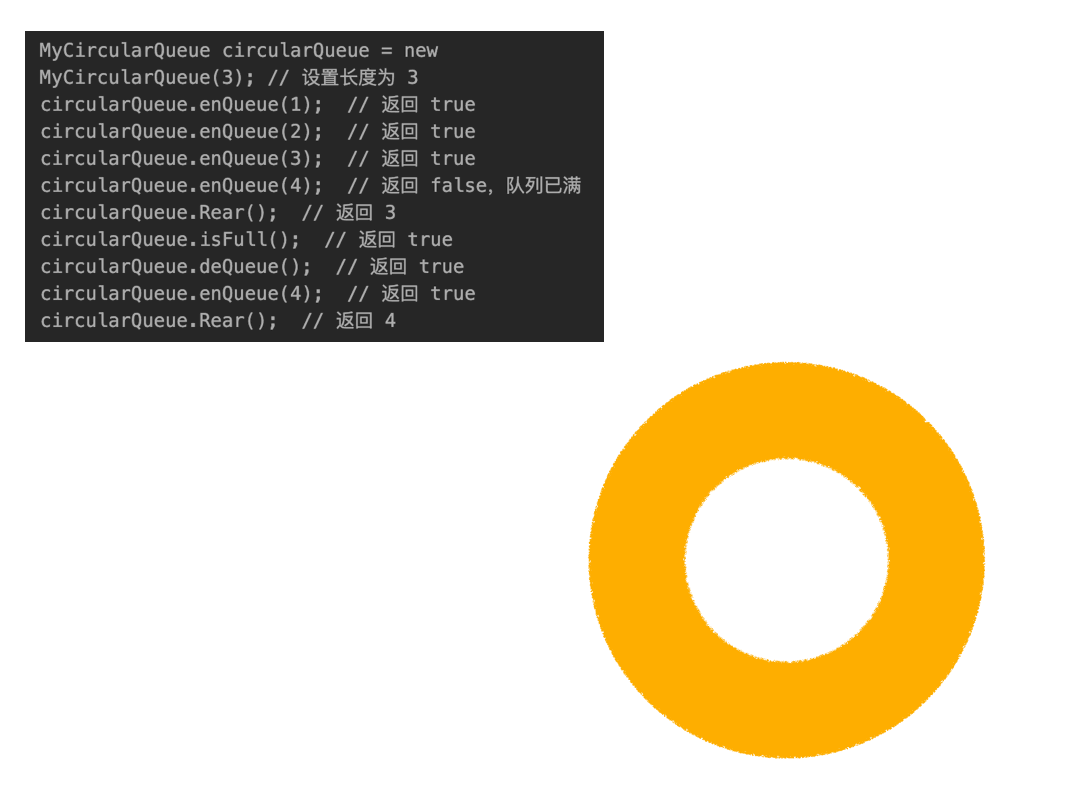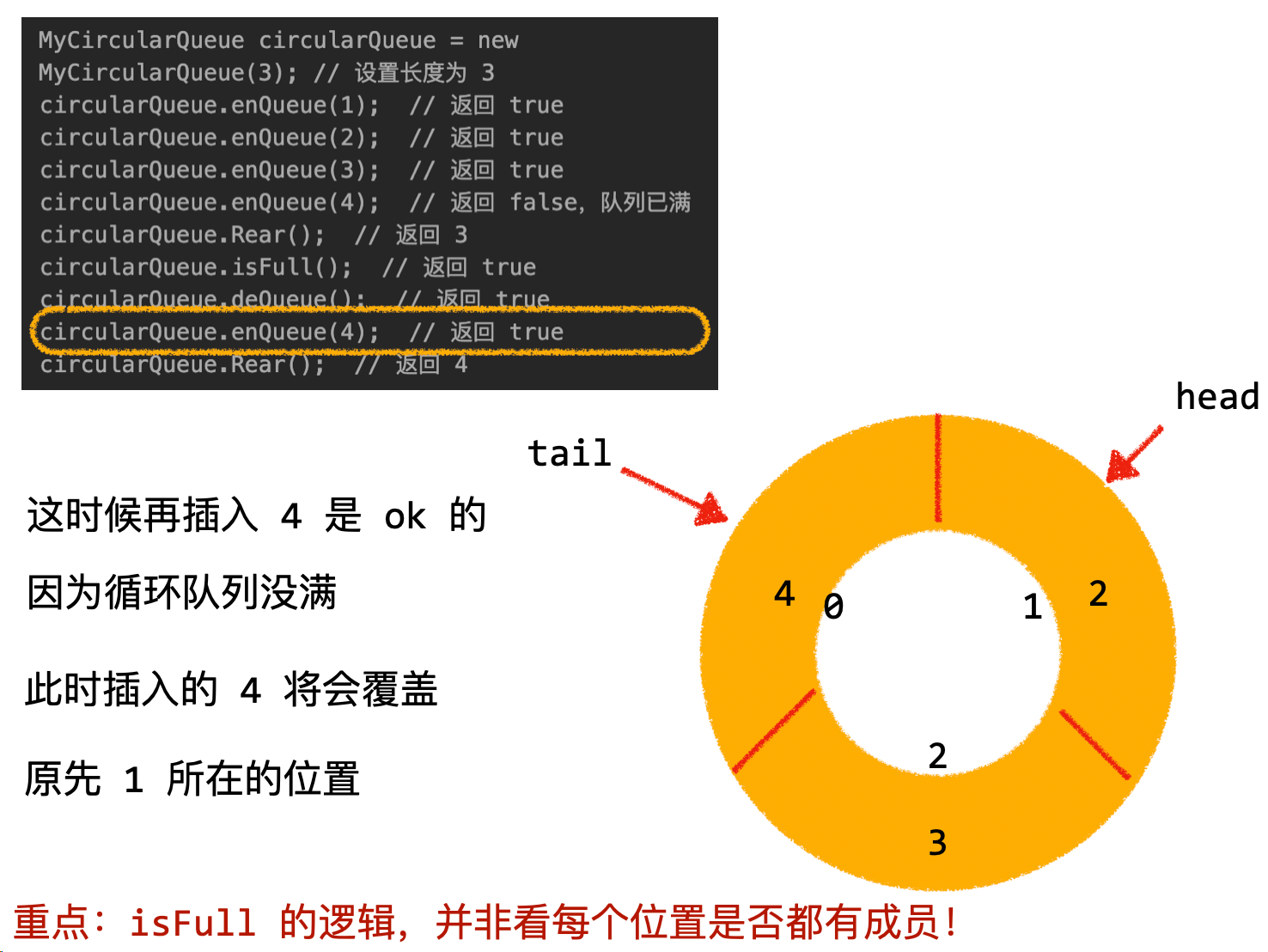0622. 设计循环队列【中等】
1. 📝 Description
leetcode
设计你的循环队列实现。 循环队列是一种线性数据结构,其操作表现基于 FIFO(先进先出)原则并且队尾被连接在队首之后以形成一个循环。它也被称为“环形缓冲器”。
循环队列的一个好处是我们可以利用这个队列之前用过的空间。在一个普通队列里,一旦一个队列满了,我们就不能插入下一个元素,即使在队列前面仍有空间。但是使用循环队列,我们能使用这些空间去存储新的值。
你的实现应该支持如下操作:
MyCircularQueue(k): 构造器,设置队列长度为 k 。Front: 从队首获取元素。如果队列为空,返回 -1 。Rear: 获取队尾元素。如果队列为空,返回 -1 。enQueue(value): 向循环队列插入一个元素。如果成功插入则返回真。deQueue(): 从循环队列中删除一个元素。如果成功删除则返回真。isEmpty(): 检查循环队列是否为空。isFull(): 检查循环队列是否已满。
示例:
java
MyCircularQueue circularQueue = new MyCircularQueue(3); // 设置长度为 3
circularQueue.enQueue(1); // 返回 true
circularQueue.enQueue(2); // 返回 true
circularQueue.enQueue(3); // 返回 true
circularQueue.enQueue(4); // 返回 false,队列已满
circularQueue.Rear(); // 返回 3
circularQueue.isFull(); // 返回 true
circularQueue.deQueue(); // 返回 true
circularQueue.enQueue(4); // 返回 true
circularQueue.Rear(); // 返回 41
2
3
4
5
6
7
8
9
10
2
3
4
5
6
7
8
9
10
提示:
- 所有的值都在 0 至 1000 的范围内;
- 操作数将在 1 至 1000 的范围内;
- 请不要使用内置的队列库。
2. 💻 题解.1 - 设计循环队列

javascript
/**
* @param {number} k
*/
var MyCircularQueue = function(k) {
this.queue = new Array(k)
this.count = 0 // 当前共有多少个成员
this.capacity = k // 容量上限
this.head = 0
this.tail = 0
};
/**
* @param {number} value
* @return {boolean}
*/
MyCircularQueue.prototype.enQueue = function(value) {
if (this.isFull()) return false
this.tail = (this.head + this.count) % this.capacity
this.queue[this.tail] = value
this.count++
return true
};
/**
* @return {boolean}
*/
MyCircularQueue.prototype.deQueue = function() {
if (this.isEmpty()) return false
this.head = (this.head + 1) % this.capacity
this.count--
return true
};
/**
* @return {number}
*/
MyCircularQueue.prototype.Front = function() {
return this.isEmpty() ? -1 : this.queue[this.head]
};
/**
* @return {number}
*/
MyCircularQueue.prototype.Rear = function() {
return this.isEmpty() ? -1 : this.queue[this.tail]
};
/**
* @return {boolean}
*/
MyCircularQueue.prototype.isEmpty = function() {
return this.count === 0
};
/**
* @return {boolean}
*/
MyCircularQueue.prototype.isFull = function() {
return this.count === this.capacity
};
/**
* Your MyCircularQueue object will be instantiated and called as such:
* var obj = new MyCircularQueue(k)
* var param_1 = obj.enQueue(value)
* var param_2 = obj.deQueue()
* var param_3 = obj.Front()
* var param_4 = obj.Rear()
* var param_5 = obj.isEmpty()
* var param_6 = obj.isFull()
*/1
2
3
4
5
6
7
8
9
10
11
12
13
14
15
16
17
18
19
20
21
22
23
24
25
26
27
28
29
30
31
32
33
34
35
36
37
38
39
40
41
42
43
44
45
46
47
48
49
50
51
52
53
54
55
56
57
58
59
60
61
62
63
64
65
66
67
68
69
70
71
72
73
2
3
4
5
6
7
8
9
10
11
12
13
14
15
16
17
18
19
20
21
22
23
24
25
26
27
28
29
30
31
32
33
34
35
36
37
38
39
40
41
42
43
44
45
46
47
48
49
50
51
52
53
54
55
56
57
58
59
60
61
62
63
64
65
66
67
68
69
70
71
72
73
deQueue 删除行为
- 遵循 FIFO 原则,最先进入的最先出去。
- 并非将元素给删掉,那个位置的值依旧是存在的,仅仅是没有指针再指向它了。
isFull 判断逻辑
在第二次执行 circularQueue.enQueue(4) 的时候可以往循环队列中插入新成员,此时维护的数组内部每个位置其实都已经是有值的状态了。由此可见在判断循环队列是否已经满了的逻辑,并非看数组的每个位置是否都有值了。

其中一种正确的做法是在内部维护一个变量 count,在每次 enQueue 成功的时候 count++,在每次 deQueue 成功的时候 count--,如果 count 的值和初始化时传入的 k 相同,那么意味着满了,否则没满。